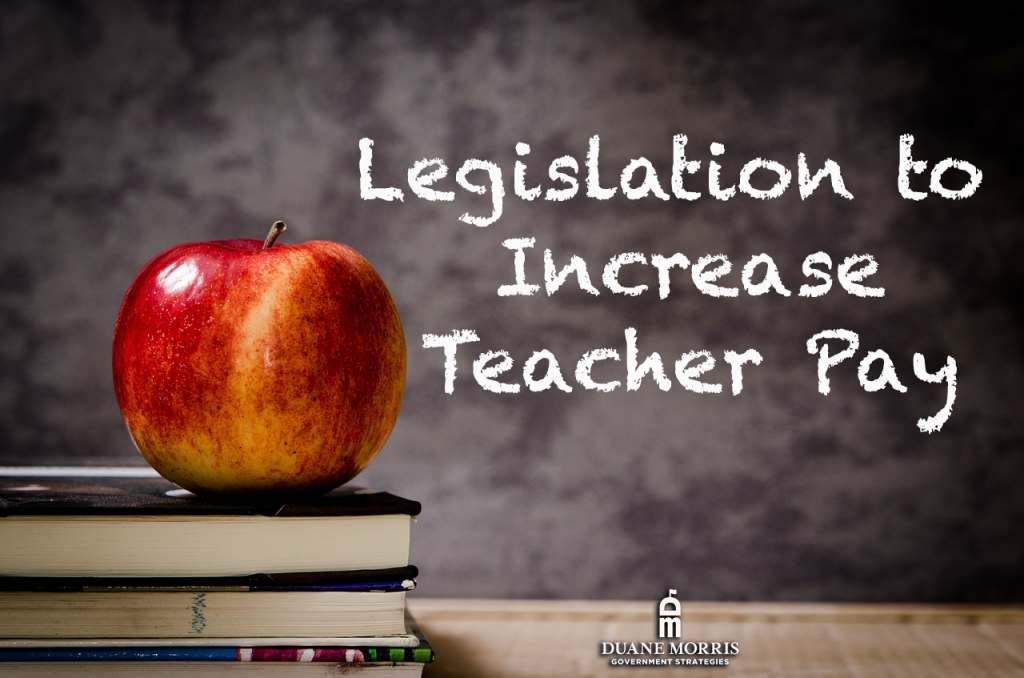
State lawmakers have acted in recent years and hope to act in 2021 to increase teacher pay. Such efforts are a critical legislative focus as salaries have chronically lagged behind inflation and productivity. The COVID-19 pandemic also continues to impact education in all American school districts. Educators have had to adjust to teaching under dramatically different circumstances.
Nationally, states’ pay to teachers, adjusted for inflation, has decreased 4.5% over the past decade. According to the National Education Association, the national average public school teacher salary for 2018-19 was $62,304. On the high end are states like New York ($85,889), California ($83,059), and Massachusetts ($82,042), while Mississippi ($45,105), West Virginia ($47,681), and New Mexico ($47,826) are at the low end.
Jump Ahead To Your State:
Florida
According to the National Education Association, a Florida public school teacher’s average salary in 2018-19 was $48,314, 47th in the nation and $13,990 below the national average.
Governor Ron DeSantis signed HB 641 into law last June, creating the Teacher Salary Increase Allocation in the Florida Education Finance Program (FEFP) to help school districts recruit and retain teachers and other instructional personnel. The 2020-21 General Appropriations Act set allocated $500 million in recurring funds from the General Revenue Fund to fund the new Teacher Salary Increase Allocation. Specifically, Florida is investing $400 million in raising full-time classroom teachers’ minimum base salary and $100 million to raise veteran teachers’ and other instructional personnel’s salaries.
Under the new legislation, the funding allows each school district and charter school to increase the minimum base salary for a full-time classroom teacher to at least $47,500 or the maximum amount achievable based on the school district’s portion of the allocation.
Pennsylvania
According to the National Education Association, a Pennsylvania public school teacher’s average salary in 2018-19 was $68,930, 10th in the nation and $6,626 above the national average.
In the Keystone State, the Pennsylvania General Assembly set the minimum compensation for teachers at $18,500 per year. Governor Tom Wolf’s 2021 legislative plan outlined a goal to increase teacher pay to a minimum salary of $45,000 per year. Governor Wolf’s plan–which he also called for during the last session–would send funding to 180 out of 500 school districts to increase teacher pay to $45,000 per year and impact 3,115 educators. The last time the minimum teacher salary saw an increase was in 1989; inflation alone would require the minimum pay to be increased 111%, to over $39,000, to match 1989 teachers’ purchasing power.
In the last legislative session, lawmakers introduced numerous bills to increase teacher pay to $45,000 per year. House Bill 1545 and Senate Bill 656 would have increased the minimum teacher salary in the Public School Code from $18,500 to $45,000. The Commonwealth would fund both bills’ increase in funding, including salary, pension, Social Security, and Medicare. The co-sponsorship memo for the bills noted that the Governor’s Budget Office estimated such costs for FY 2019-20 would have been $9.8 million for salary, $142,000 for Medicare, $610,000 for Social Security, and $3.3 million for pensions.
Lawmakers failed to advance either bill and have not re-introduced either in the 2021 legislative session at this point.
Arkansas
According to the National Education Association, an Arkansas public school teacher’s average salary in 2018-19 was $49,438, 46th in the nation and $12,866 below the national average.
In January, Governor Asa Hutchinson called for lawmakers to increase teacher pay by $2,000 over the next two years. Hutchinson noted that lawmakers had increased teacher pay two years ago, but he supports another round of increases. The average teacher salary last year was $49,822, according to the Arkansas Department of Education. Increasing teacher pay by $2,000 a year would cost approximately $25 million.
Legislation to enact the governor’s proposal to increase teacher pay would create the Teacher Salary Equalization fund. Under the legislation, the Arkansas Department of Education would review salary data every year. Districts and charter schools with average teacher salaries below $51,822 would be eligible for monies from the fund. The proposal already appears to have the support of the Arkansas Senate Education Committee Chairwoman. Simultaneously, the House Education Committee Chairman wants to see more details about where the funding would come from.
Montana
According to the National Education Association, a Montana public school teacher’s average salary in 2018-19 was $50,721, 42nd in the nation and $11,583 below the national average.
Some Montana lawmakers hope to increase the starting salary for teachers in the state. The current average starting salary of a Montana teacher was $32,132 in 2018-29, 51st in the country and $8,022 lower than the national average of $40,154. House Bill 143, which passed the legislature last month, would incentivize schools to increase starting teachers’ base pay scale if school districts determine salaries on a scale that uses experience and education to get closer to the average salary. The bill’s incentive would double a payment already made to schools for each teacher in the district’s classroom.
The bill incentivizes a district with teacher base pay at least ten times as much as the quality educator payment amount (currently $3,385), bringing it to $33,850. The Fiscal Note for HB 143 estimates such incentives will cost $2.5 million for FY 2023, $2.8 million in FY 2024, and $3.08 million in FY 2025.
Governor Greg Gianforte supports the bill and included the incentive in his budget proposal. The governor’s policy director noted base pay in neighboring states is higher than in Montana. Hence, the state is and would still be losing teachers. Base pay in North and South Dakota is $6,000 higher per year, while base pay in Wyoming is $14,000 higher for a first-year teacher. The starting averages in all neighboring states are Idaho ($36.4k), South Dakota ($38.8k), North Dakota ($39.7k), and Wyoming ($45.8k).
Mississippi
According to the National Education Association, a Mississippi public school teacher’s average salaries in 2018-19 was $45,105, 51st in the nation and $17,199 below the national average.
Lawmakers in the Mississippi Senate unanimously approved Senate Bill 2001 in January. The bill, which awaits action in the House, would increase teacher pay by $1,000 for all teachers and increase teachers’ starting salary to $37,000 (an increase of $1,100). The bill would also increase the minimum salary for assistant teachers to $15,000.
An identical piece of legislation was expected to pass the legislature last session. However, lawmakers derailed the bill’s passage citing the pandemic and the state budget.
South Carolina
According to the National Education Association, a South Carolina public school teacher’s average salary in 2018-19 was $50,882, 40th in the nation and $11,422 below the national average.
South Carolina lawmakers paused an estimated 2% pay increase for 2020-21 public school teachers last year due to financial uncertainties caused by the pandemic. However, the South Carolina State House passed H 3609 in late January. The bill specifically appropriates $50 million from the 2018-19 Contingency Reserve Fund to provide teacher step increases for the 2020-21 school year.
The bill awaits consideration in the State Senate. If approved, H 3609 would take effect immediately upon approval by the governor.
Tennessee
According to the National Education Association, a Tennessee public school teacher’s average salary in 2018-19 was $51,349, 37th in the nation and $10,955 below the national average.
Tennessee lawmakers wrapped up a special session on education in January. Lawmakers held the special session to address learning loss and the adverse effects on students in reading and math due to time away from the classroom caused by the pandemic.
Included in the legislation passed by lawmakers was $42 million more toward instructional salaries. The effort to increase teacher pay equates to a 2% funding increase toward the salaries of teachers and other educators (i.e., administrators, counselors, librarians, and social workers). However, once the increased allocation moves through the state’s Basic Education Program, the salary increase will realistically end up being only 1%.
Governor Bill Lee has said he will propose to increase teacher pay by 4% in next year’s state budget, which would begin on July 1.
Related: When will teachers receive the COVID-19 vaccine?
Find out when educators are scheduled to receive the COVID-19 vaccine in our COVID-19 Vaccine Plans by State 50 State Guide.
Latest News
Photo credit: iStock.com/Naypong The rise of Name, Image, and Likeness (NIL) rights has revolutionized collegiate athletics, empowering student-athletes to monetize their personal brands while maintaining eligibility, something we previously covered in 2023. Since California's groundbreaking [...]
Photo credit: iStock.com/runna10 Every year in the United States, a growing number of teachers leave their positions. While there are multiple reasons for this alarming trend, many teachers point to inadequate compensation as a significant [...]
Photo credit: iStock.com/yacobchuk The use of cell phones by students in classrooms is on the rise, despite 77% of schools prohibiting cell phones at school for non-academic use. With students often disregarding these rules or [...]
Photo credit: iStock.com/SeventyFour According to the Centers for Disease Control and Prevention (CDC), the number of adolescents reporting poor mental health is on the rise. A 2022 CDC report showed that 37% of high school [...]






Stay In Touch